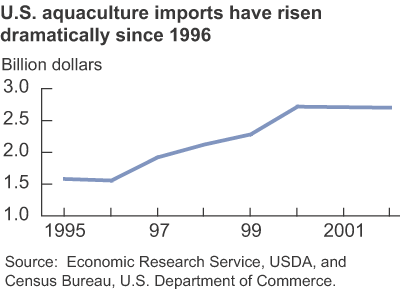U.S. Seafood Market Shifts to Aquaculture
- by David Harvey
- 4/1/2004
The wild harvest of seafood, man’s last major hunting and gathering activity, is at a critical point. Technology has enabled harvesting to outpace the speed at which species can reproduce.
In response, the seafood industry is beginning to shift from wild harvest to aquaculture, the production of aquatic plants and animals under grower-controlled conditions. Aquaculture is growing rapidly in many countries, particularly China, Chile, and Thailand. It is also expanding in the United States—the estimated value of U.S. production in 2001 was $935 million. Aquaculture accounts for a growing share of U.S. seafood consumption as well.
Aquaculture has a number of advantages over wild harvest. Growers can more easily maintain a steady supply of products. Farmed seafood is likely to be more uniform in size and quantity, thus moderating price swings. Selective breeding can be used to enhance disease resistance, increase growth rates, or promote other desirable traits, such as better feed conversion. Finally, consumers benefit from declining real prices as growers increase their efficiency and supply.
There are also a number of possible disadvantages to farmed seafood production. These include waste disposal from intensive production sites, the introduction of non-native species, and the destruction of coastal marsh areas for the development of new production areas. Concerns have also been raised about possibly dangerous levels of cancer-causing chemicals in farmed salmon.
Despite such concerns, the U.S. has become a major market for the global aquaculture industry. U.S. seafood consumption has been steady over the past decade at around 16 pounds per person per year, but a growing share of the supply is being imported, much of it from countries using aquaculture. In 2002, imports accounted for roughly 45 percent of seafood consumed in the U.S. Seafood imports included shrimp (946 million pounds), Atlantic salmon (413 million pounds), and tilapia (148 million pounds). Most of the imported salmon and tilapia and approximately half the shrimp were farm-raised, representing over 1 billion pounds of aquaculture products with a value of $2.7 billion. To put these imports in perspective, the U.S. poultry industry, the world’s largest poultry exporter, shipped 5.4 billion pounds of poultry products, valued at $1.6 billion in 2002. Aquaculture also supplies U.S. consumers with catfish from Vietnam, crayfish and mollusks from China, and mussels from Canada and New Zealand.
For a number of countries, aquaculture has become a major part of their economies and a growing source of foreign exchange earnings. For the U.S., the large influx of imported aquaculture products has meant lower prices for consumers, but lower returns for producers. In response, a number of anti-dumping suits have been filed against foreign aquacultural producers.
This article is drawn from:
- Aquaculture. (n.d.). U.S. Department of Agriculture, Economic Research Service.
- Aquaculture Outlook. (2003). USDA/ERS. LDP-AQS-17..


